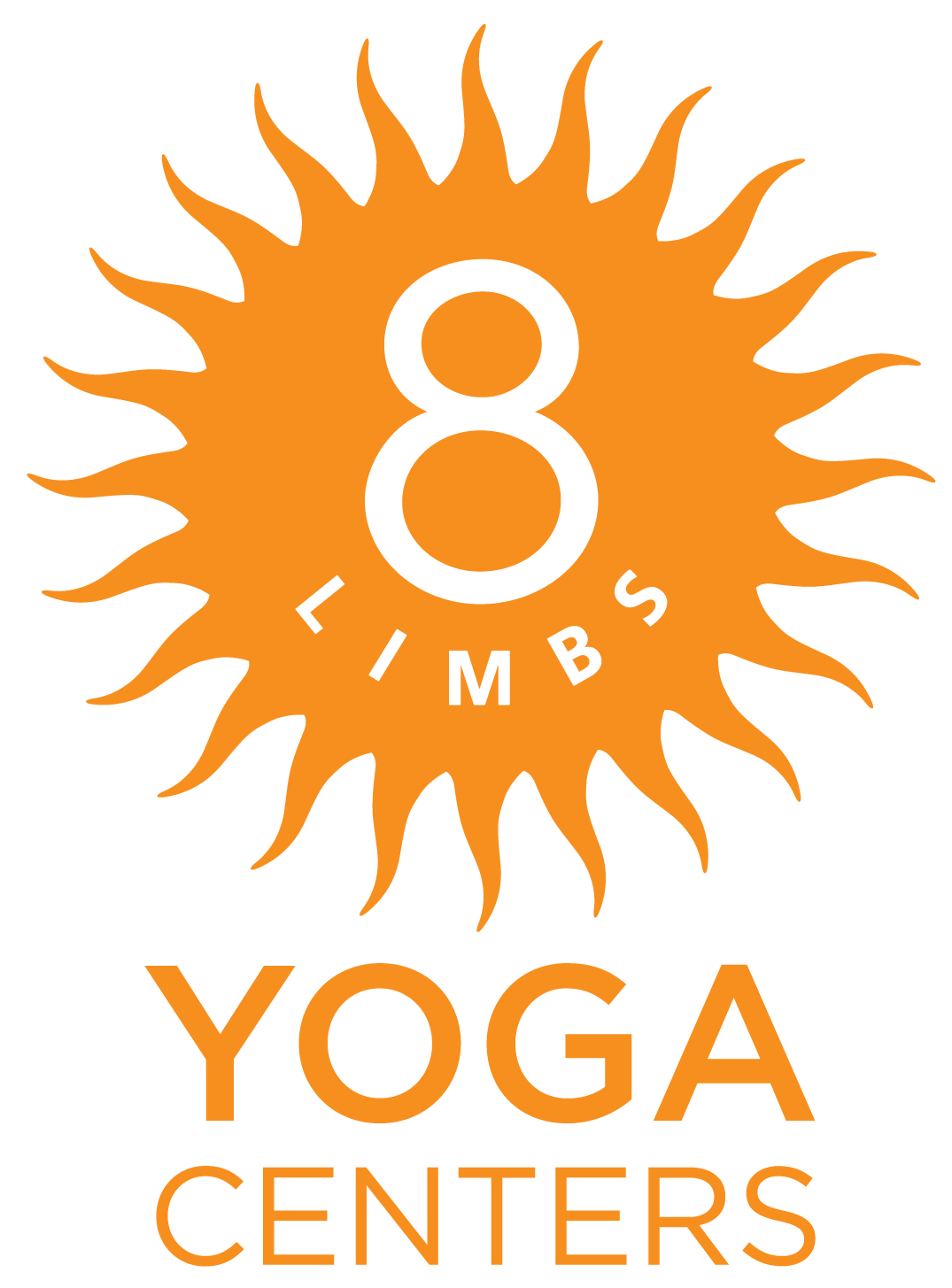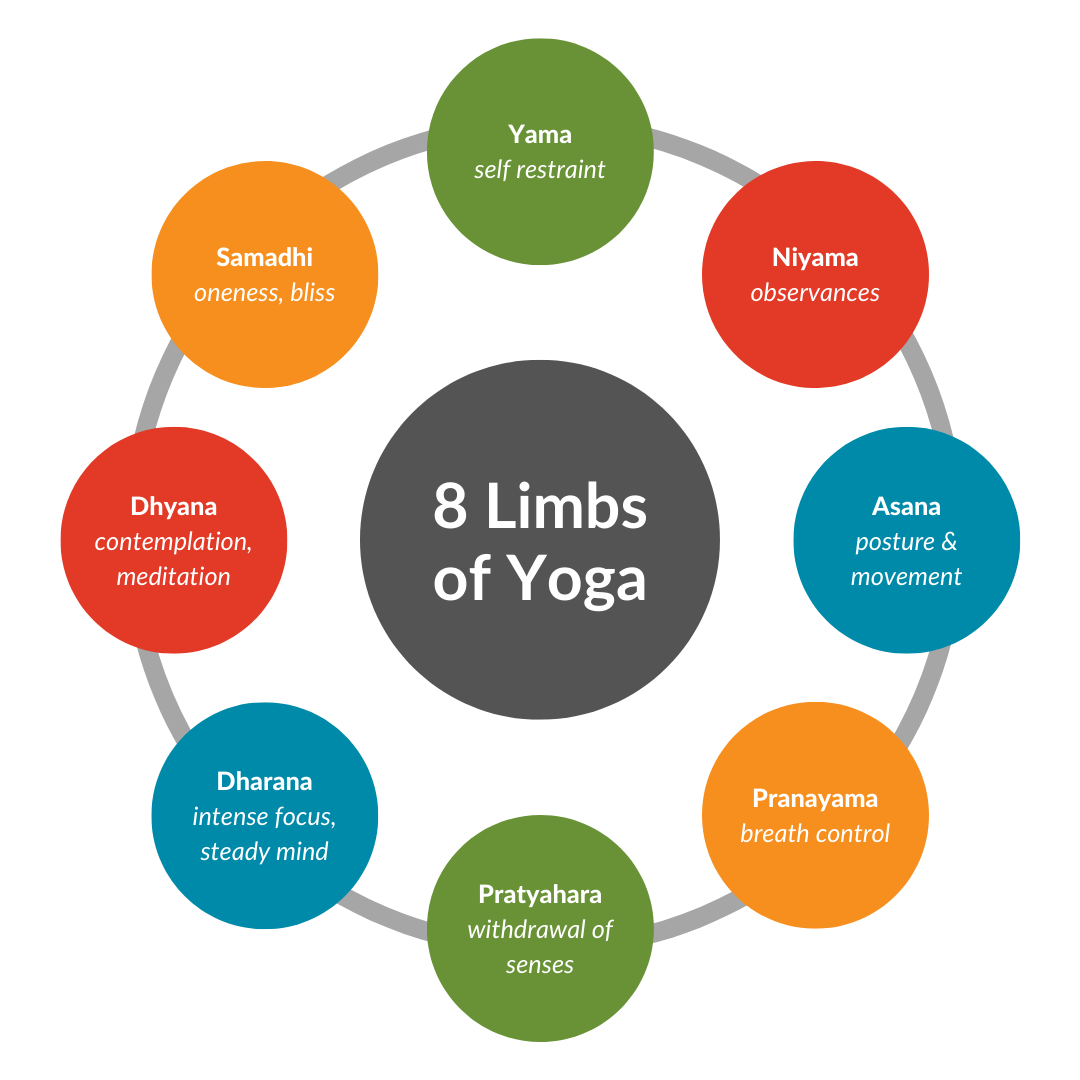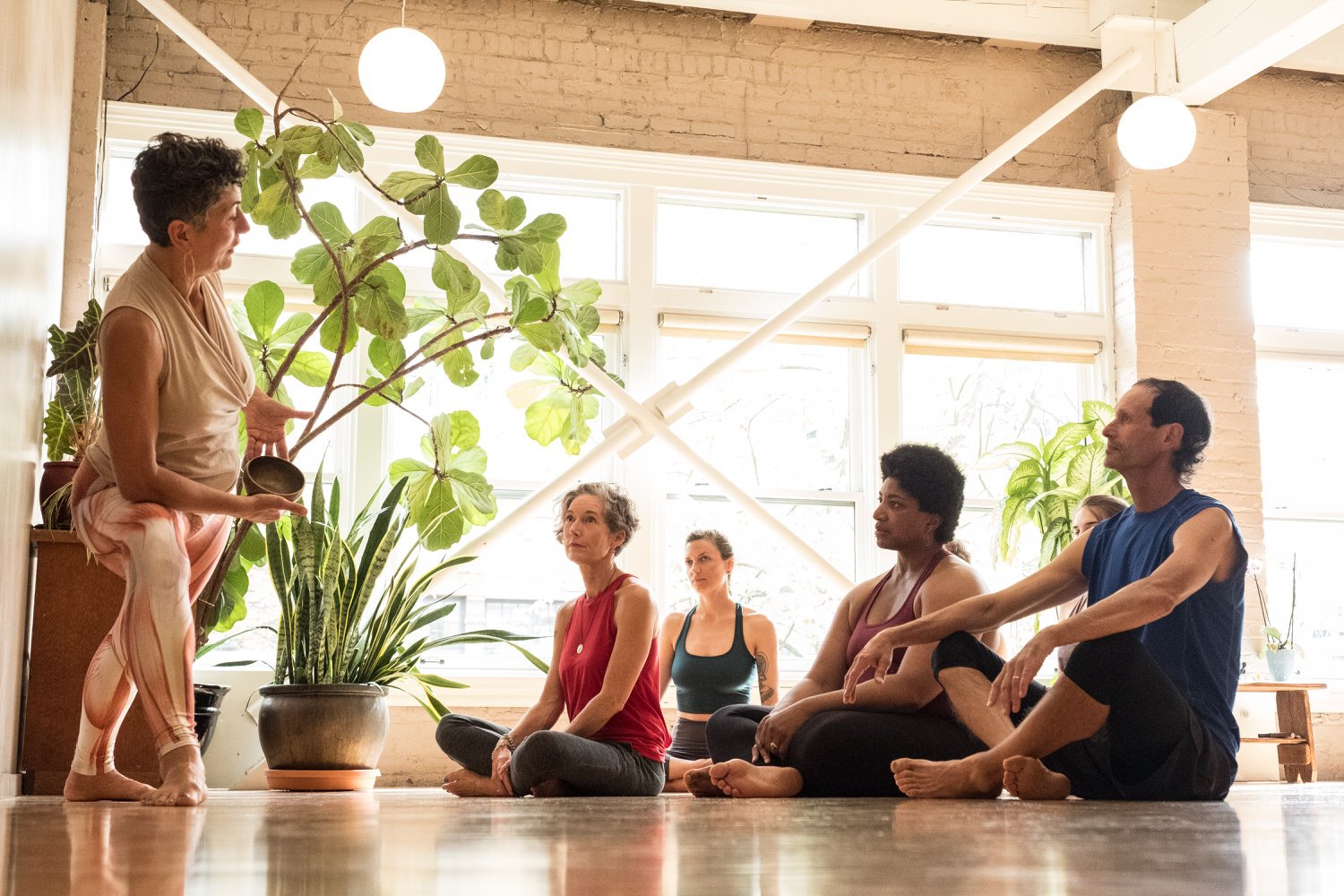
The 8 Limbs of Yoga
At 8 Limbs Yoga Centers, we believe in embracing the holistic path of yoga, which encompasses not just physical postures (asanas), but also ethical principles, breath control, meditation, and self-realization. Rooted in ancient yogic philosophy, the Eight Limbs of Yoga serve as a comprehensive guide for living a meaningful and balanced life.
What are the 8 Limbs of Yoga?
In Patanjali's Yoga Sutra, the eightfold path is called ashtanga, which literally means 'eight limbs' (ashta=eight, anga=limb). These eight steps, commonly known as the Eight Limbs of Yoga, provide a systematic approach to spiritual growth and self-discovery. Each limb builds upon the previous one, leading the practitioner toward a state of harmony, contentment, and enlightenment.
-
Ahimsa (Non-violence): Practicing kindness, compassion, and non-harming towards all beings.
Satya (Truthfulness): Being honest in thoughts, speech, and actions.
Asteya (Non-stealing): Respecting others' property and refraining from theft.
Brahmacharya (Moderation): Exercising moderation in all aspects of life, including sensory pleasures.
Aparigraha (Non-attachment): Letting go of possessiveness and cultivating contentment with what we have.
-
Saucha (Purity): Purifying the body, mind, and surroundings.
Santosha (Contentment): Finding satisfaction and gratitude in the present moment.
Tapas (Discipline): Cultivating self-discipline and dedication to spiritual practice.
Svadhyaya (Self-study): Engaging in self-reflection, study of sacred texts, and introspection.
Ishvara Pranidhana (Surrender to the Divine): Surrendering to a higher power and trusting in the universal intelligence.
-
Asanas refer to the physical postures practiced in yoga. They help cultivate strength, flexibility, and balance in the body, while also promoting mindfulness and concentration.
-
Pranayama involves breath control techniques that regulate the flow of prana (life force energy) in the body. Through pranayama, practitioners learn to harness the breath to calm the mind, increase vitality, and balance the nervous system.
-
Pratyahara is the withdrawal of the senses from external stimuli. By turning our attention inward, we can cultivate greater introspection, concentration, and inner awareness.
-
Dharana refers to concentration or single-pointed focus. Through concentration practices, we develop mental clarity, stability, and the ability to control the fluctuations of the mind.
-
Dhyana: Dhyana is meditation, the practice of sustained focus and contemplation. In meditation, we cultivate a deeper connection with our true nature and experience a sense of unity with the universe.
-
Samadhi is the ultimate goal of yoga, often described as a state of pure consciousness and blissful union with the divine. In Samadhi, the individual ego dissolves, and there is a profound sense of interconnectedness and oneness.
Benefits of Yoga
Yoga’s benefits affect each person in a different way. Many find that it helps them to relax; others find themselves feeling healthier and more energetic. All the systems in the body-from the lymphatic to the digestive to the cardiovascular-benefit from yoga. Yoga benefits every aspect of our bodies, inside and out.
On the inside, yoga enables relaxation. Many practitioners find that yoga helps them to focus and feel relaxed in both work and play. Many studies have shown that the stress hormone cortisol had decreases even after just one session of yoga.
Yoga has also been found to increase alpha and theta waves in the brain, meaning that yoga can relax the brain and increase access to the subconscious and emotions. And by simply increasing the feel-good brain chemicals like endorphins, enkephalins, and serotonin, yoga practitioners just feel better.
On the outside, yogis look terrific. This is probably from improvements on the inside! Since yoga balances the metabolism and provides exercise, many find yoga brings their body into balance. Physical yoga strengthens and tones the muscles while improving balance and posture. And yoga is a great way to cross-train for other sports; it can ease strains from injuries and increase strength and flexibility.
When all the body’s systems are balanced, yoga practitioners feel healthier and find they want to make other healthy choices in their life.
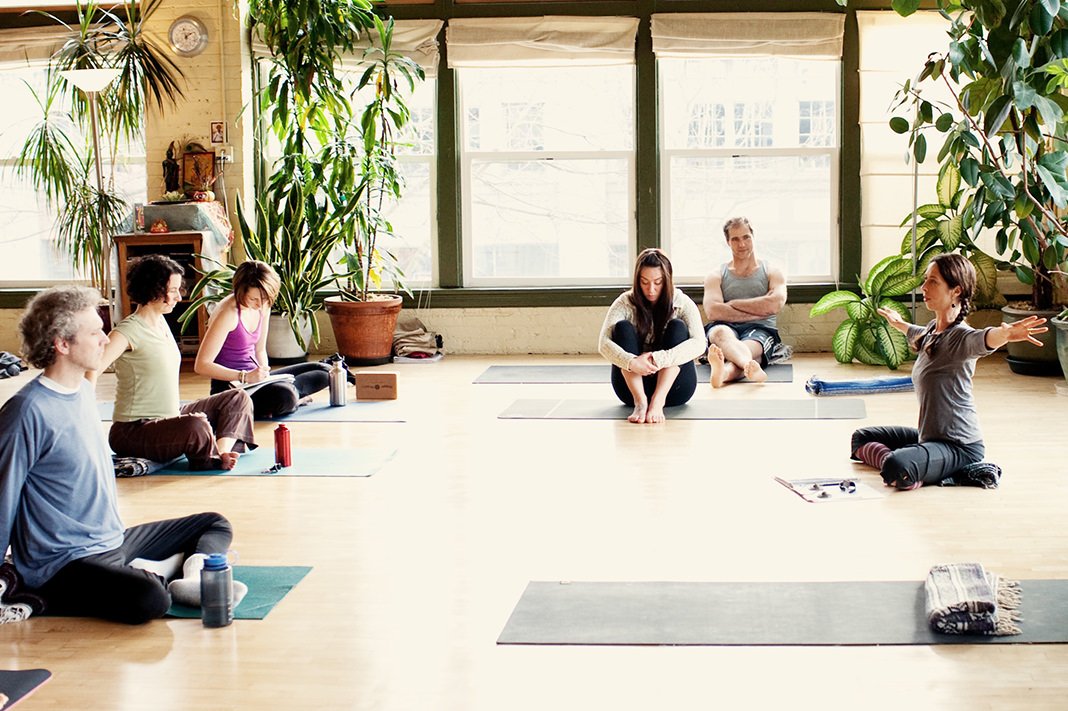
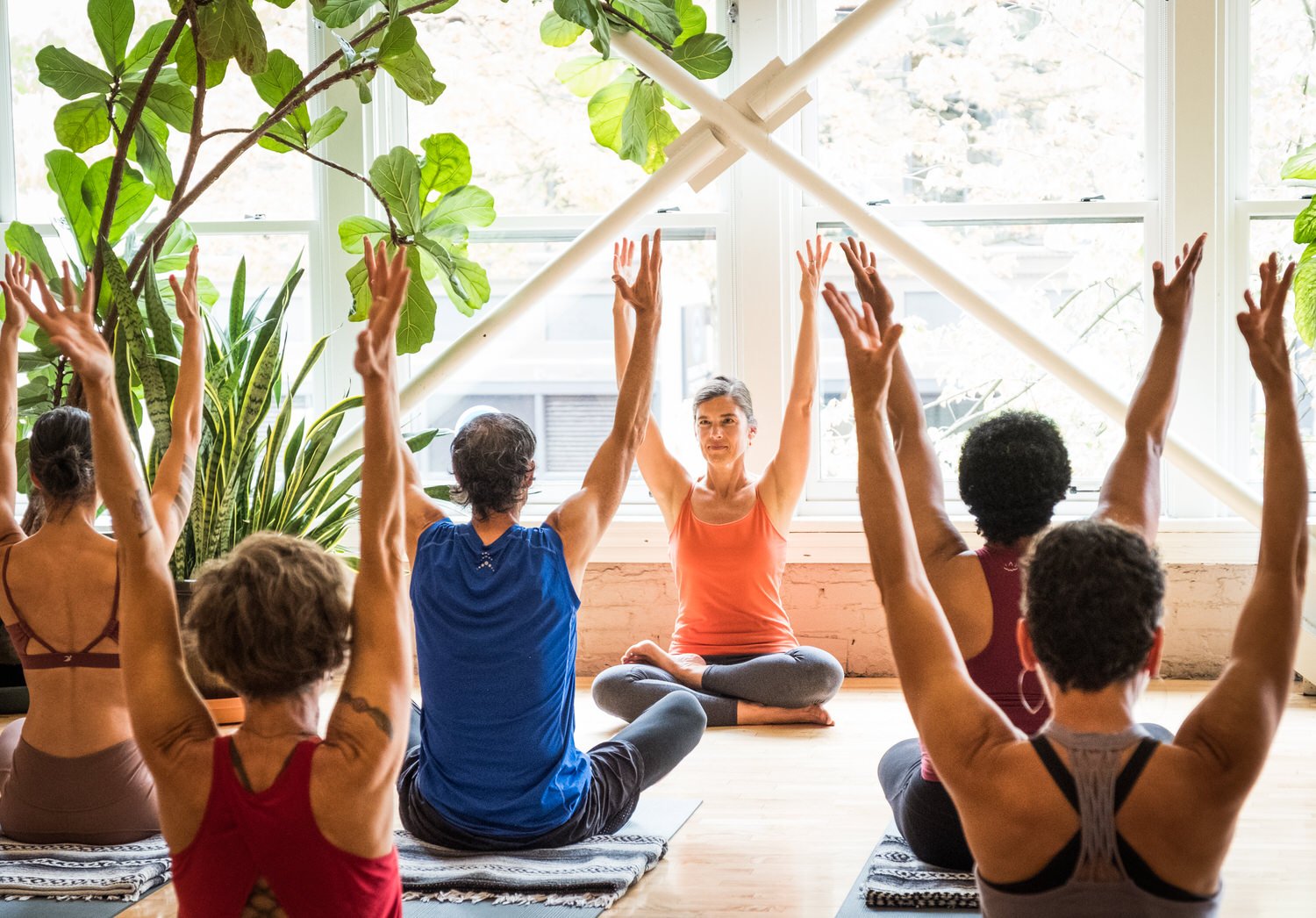
BRANCHES OF YOGA
Hatha Yoga is the physical practice of yoga. The asana practice of hatha yoga symbolizes the connection of the sun and the moon, bringing the world and the physical body into balance. Hatha also means “to strike,” meaning to strike the body with the challenge of the postures and to “yoke” (the meaning of yoga) the mind into singular focus. Most styles of yoga in the United States are based in Hatha with different philosophies, practices, and terminology that allow yoga to fit the individual practitioner. Its traditional source in relation to the postures is the Hatha Yoga Pradipika. See below for more information on styles of Hatha yoga.
-
is the Royal Path (“raja” means king), the yoga of meditation. Its focus is to quiet the mind. The practitioner’s attention is fixed on an object, mantra, or concept. Whenever the mind wanders it is brought back to the object of concentration. In time the mind will cease wandering and become completely still. Raja yoga practitioners aim to establish “a mental link with the supreme source of all spiritual energy and power, the Supreme Soul, with the purpose of freeing the individual soul from misery, pain, fear, illness, and phobias, and enabling the soul to experience peace, happiness and lasting health and prosperity.”
-
is the yoga of knowledge. Jnana yoga is closely associated with Advaita Vedanta, one of the six philosophies of Hinduism. Advaita Vedanta believes that everything in the universe shares a single soul, including all living creatures and God. Jnana yoga is the wisdom associated with discerning the Real from the unreal or illusory.
-
is the yoga of devotion. In Bhakti yoga, the practitioner’s emotional force is concentrated and channeled toward the Divine. Bhakti practitioners are openly expressive; their devotion is sometimes compared to a love-relationship with a divine being. Kirtan, devotional singing, is a popular practice of Bhakti yoga.
-
Karma Yoga is the yoga of service to others and to God. Karma yoga practitioners renounce the fruits of action. Activities are assumed for the benefit of the greater good, without concern for personal benefit. The path of Karma-Yoga is described in detail in the Bhagavad-Gita: “Be intent on action; not on the fruits of action.”
STYLES OF HATHA YOGA
There are many styles or schools of Hatha Yoga. Here are a few that inform the teachers here at 8 Limbs, as well a recognition of the “grandfather of modern yoga”, Krishnamacharya.
T. Krishnamacharya, a South Indian yogi born in 1888, is said to be the “grandfather of modern yoga.” One of Krishnamacharya’s key philosophies was that yoga should be adapted to the individual, not the individual to yoga. This rule informed his practice as he taught many of the 20th century’s leading yogis, including Pattabhi Jois, Iyengar, and his son, TKV Desikachar, who were instrumental in bringing yoga to the West. These are the teachers that have most inspired 8 Limbs’ philosophy. The schools or styles of yoga that were developed by these teachers are the first three mentioned below.
-
is a fast-paced, flowing series of sequential postures as prescribed by yoga master K. Pattabhi Jois, who was an early student of Krishnamacharya’s. There are six series of asanas that increase in difficulty, allowing students to work at their own pace. Asanas are connected by the breath and are linked with sun salutations. Most classes taught in the United States focus on the Primary Series.
-
Iyengar Yoga was developed in Pune, India by BKS Iyengar, one of the most influential yogis of his time. Iyengar was a student of Krishnamacharya’s and took what he learned to cure himself of disease through asana and pranayama. In the Iyengar method, special attention is paid to precise muscular and skeletal alignment. Poses (especially standing postures) are typically held much longer than in other schools of yoga to allow for adjustments to be made. The Iyengar system also uses props, such as belts, chairs, blocks, and blankets, to help accommodate any special needs such as injuries or structural imbalances.
-
Viniyoga means yoga for the individual. As Krishnamacharya aged and taught his son TKV Desikachar, he focused on the adapting asana, pranayama and other yoga practices (ritual, chanting, prayer) to the individual. Viniyoga focuses on the traditional teachings of yoga and the adherence to a practice that serves the individual needs of the practitioner.
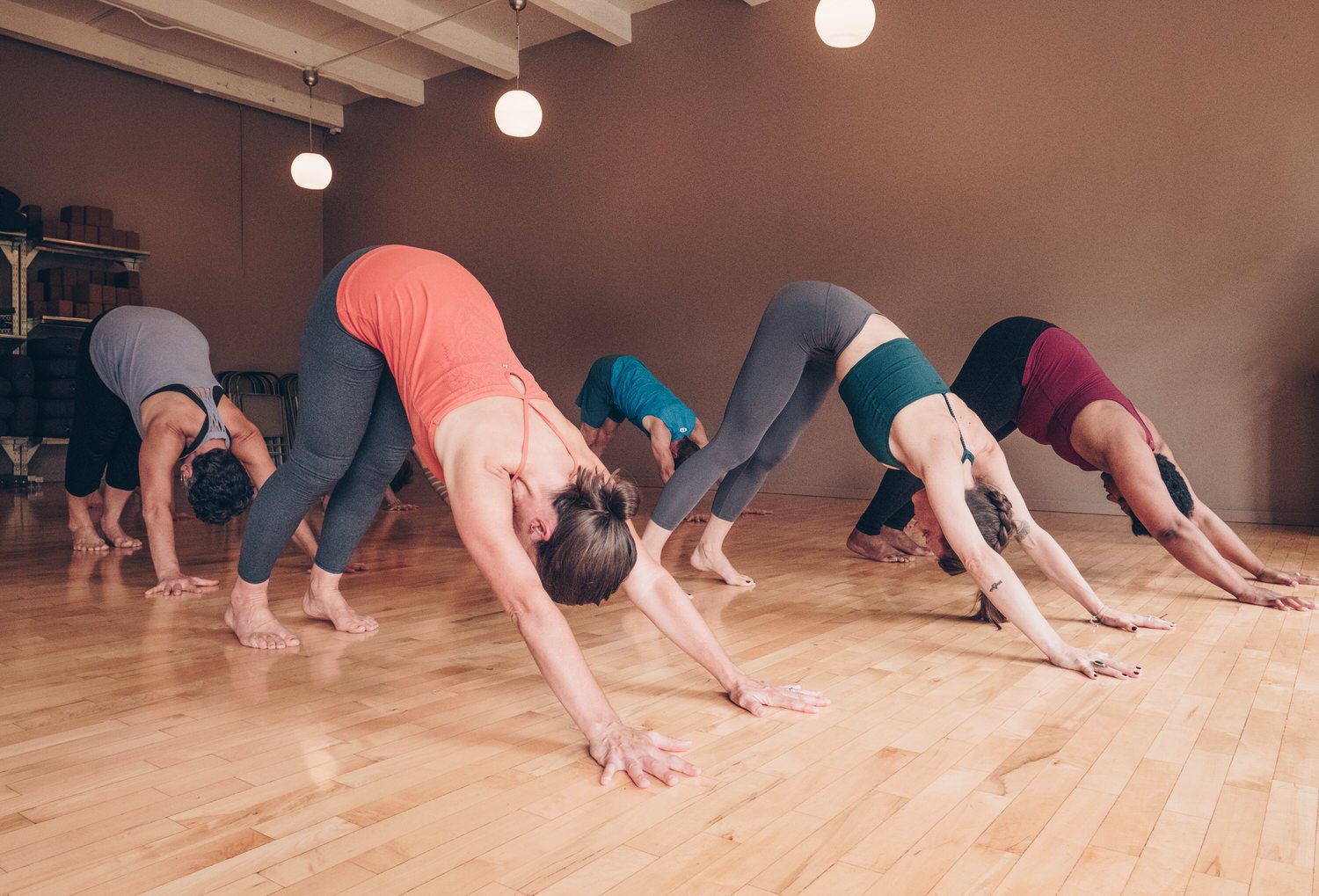

Recommended Reading
ANATOMY
Anatomy of Movement, Blandine Calais-Germain
GENERAL YOGA
The Heart of Yoga, TKV Desikachar
Jivamukti Yoga, Sharon Gannon and David Life
The Poetry of the Body, Rodney Yee
Yoga for Wellness, Gary Kraftsow
Yoga Mind Body and Spirit, Donna Farhi
Yoga, The Spirit And Practice Of Moving Into Stillness, Erich Schiffman
ASANA
Light on Yoga, BKS Iyengar
Yoga, the Iyengar Way, Silva, Mira & Shyam Mehta
PRANAYAMA
The Breathing Book, Donna Farhi
Light on Pranayama, BKS Iyengar
YOGA PHILOSOPHY
Bhagavad Gita, commentary by Eknath Easwaren
Bhagavad Gita, translated by Barbara Stoler Miller
Bringing Yoga to Life, Donna Farhi
The Essence of Yoga, Bernard Bouanchard
Light on the Yoga Sutras, BKS Iyengar
Meditations from the Mat, Rolf Gates
Yoga for Transformation, Gary Kraftsow
The Yoga Sutras of Patanjali, Swami Satchitanada
A Sourcebook in Indian Philosophy, Sarvepalli Radhakrishnan and Charles Moore, eds.
